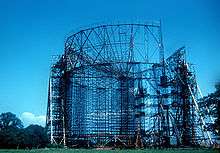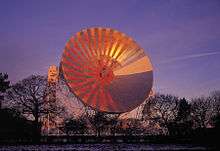Timeline of Jodrell Bank Observatory
This is a timeline of Jodrell Bank Observatory.
1930s
- 1939 — Jodrell Bank site purchased by the University of Manchester as a botany field station.[1]
1940s

Observations at Jodrell Bank in 1945.
- 1945, December — Bernard Lovell arrives at Jodrell Bank with several trailers of radar equipment from World War II.[2]
- 1947 — The 66 meter Transit Telescope is constructed.[3][4]
1950s

The Mark 1 under construction.
- 1950, August — The transit telescope is used to make the first detection of radio waves from the nearby Andromeda Galaxy.[5][6]
- 1950 — Charles Husband presents first drawings of the proposed giant, fully steerable radio telescope.[7]
- 1952, September — Construction of the Mark I telescope begins.[8]
- 1957, October — The Mark I telescope becomes operational. It tracks the carrier rocket of Sputnik 1; the only telescope in the West able to do so.[9][10]
1960s
- 1960, May — Lord Nuffield pays the remaining debt on the Mark I and the observatory is renamed the Nuffield Radio Astronomy Laboratories.[11]
- 1962 — As part of a radio-linked interferometer, the Mark I identifies a new class of compact radio sources, later recognised as quasars.[12]
- 1962 — Jodrell Bank radio telescope is mentioned in the Science Fiction novel A for Andromeda by Fred Hoyle and John Elliot.
- 1964 — The Mark II telescope is completed.[13]
- 1966 — The Mark I receives pictures from Luna 9, the first spacecraft to make a soft landing on the Moon.[14]
- 1966 — The Mark III telescope is completed.[15]
- 1968 — The Mark I confirms the existence of pulsars.[16]
- 1968 — The Mark I took part in the first transatlantic VLBI experiment in 1968, with other telescopes being those at Algonquin and Penticton in Canada.[17]
- 1969 — The Mark I is used for the first time in a VLBI observation, with the Arecibo radio telescope in 1969.[12]
1970s
- 1970–1971 — The Mark I is repaired and upgraded; it is renamed to the Mark IA.[15]
- 1972–1973 — The Mark I carries out a survey of radio sources; amongst these sources was the first gravitational lens, which was confirmed optically in 1979.[18]
- 1976, January — storms bring winds of around 90 mph which almost destroy the telescope. Bracing girders are added.[19]
1980s
- 1980 — The Mark IA is used as part of the new MERLIN array.[12]
- 1982 — The 42 ft telescope is built, to replace the 50 ft.
- 1986 — The first pulsar in a globular cluster is discovered.[12]
- 1986 — The Mark II telescope is given a new surface that is accurate to 1/3 mm.[13]
- 1987 — The Mark IA is renamed the Lovell Telescope after Bernard Lovell.[20]
1990s
- 1990 — The new 32 m Cambridge telescope at Mullard Radio Astronomy Observatory is added to the MERLIN array.[12]
- 1992 — The MERLIN array becomes a national facility.[12]
- 1993 — At the request of NASA, the Lovell Telescope searches for the Mars Observer spacecraft.[21]
- 1998 — The Lovell Telescope begins participation with the SETI Project Phoenix[22][23]
2000s

The Lovell telescope mid-resurfacing.
- 2000, February — The Lovell Telescope searches for NASA's Mars Polar Lander.[24]
- 2000 — Placebo recorded the video for The Bitter End at Jodrell Bank.
- 2000–2002 — The Lovell Telescope is resurfaced, increasing its sensitivity at 5 GHz by a factor of five.
- 2003, December — The Lovell Telescope searches for the Beagle 2 lander on Mars.
- 2004, January — Astronomers from Jodrell Bank, Australia, Italy and the U.S. discover the first known double pulsar.
- 2004 — Minor scenes for the film of the Hitchhiker's Guide to the Galaxy are filmed at Jodrell Bank.
- 2005, February — Astronomers using the Lovell Telescope discovered a galaxy that appears to be made almost entirely of dark matter.[25]
- 2005, March — Jodrell Bank becomes the centre of the World's largest scale model of the Solar System as part of the Spaced Out project.[26]
- 2006, September — Jodrell Bank wins the BBC's online competition to find the UK's greatest "Unsung Landmark".[21]
2010s
- 2011, March — Jodrell Bank is included on the UK Tentative List for nomination as a UNESCO World Heritage Site[27]
- 2019, July — The observatory becomes a UNESCO World Heritage Site.[28][29]
gollark: 1. uninstall useless software2. do not reinstall it
gollark: I don't even *use* Windows! That's why I have slightly faster RAM than I otherwise would have.
gollark: If it breaks add it back again.
gollark: ALL OF IT.
gollark: Well do that.
References
- History on U of manchester web site, accessed 24/10/2007
- Story of Jodrell Bank, p. 3
- "Jodrell Bank Observatory - The Early History". Retrieved 2007-06-10.
- Story of Jodrell Bank, p. 17
- Out of the Zenith, p. 7
- Astronomer by Chance, p. 175
- Lovell, Story of Jodrell Bank, p. 35
- Lovell, Story of Jodrell Bank, p. 44
- Lovell, Story of Jodrell Bank, p. 196
- Lovell, Astronomer by Chance, p. 262
- Story of Jodrell Bank, p. 244
- "JBO - Milestones". Retrieved 2007-05-28.
- "The MKII Radio Telescope". Jodrell Bank Observatory. Retrieved 2007-06-01.
- Lovell, Story of Jodrell Bank, p. 250
"On This Day - 3 February 1966: Soviets land probe on Moon". BBC News. 1966-02-03. Retrieved 2007-04-09.
"The Lunar Landscape". Time Magazine. 11 February 1966. Retrieved 2007-04-07. - Lovell, The Jodrell Bank Telescopes
- Lovell, Out of the Zenith, pp. 130-135
- Lovell, Out of the Zenith, pp. 67-68
- Lovell, Astronomer by Chance, pp. 297-301
- "The MKIA Radio Telescope". Jodrell Bank Observatory. Retrieved 2006-11-21.
- "Lovell Radio Telescope refurbished". BBC News. 28 April 2003. Retrieved 2007-04-05.
- Rohrer, Finlo (5 September 2006). "Aye to the telescope". BBC News.
- "Scientists listen intently for ET". BBC News. 1 February 1998. Retrieved 2007-04-09.
- "Alien hunters back on track". BBC News. 23 March 1999. Retrieved 2007-04-09.
- "Earth turns its ears to Mars". BBC News. 2 October 2000. Retrieved 2007-04-09.
"Quiet please, we're listening to Mars". BBC News. 3 February 2000. Retrieved 2007-04-05.
"Mars lander search goes on". BBC News. 8 February 2000. Retrieved 2007-04-05. - "Seeing the invisible — first dark galaxy discovered?". Jodrell Bank Observatory press release. 23 February 2005. Retrieved 2007-05-29.
- "SpacedOut Location: The Sun at Jodrell Bank". Archived from the original on 2005-12-13. Retrieved 2007-06-08.
- "Jodrell Bank bids for world heritage status". Inside the M60. 22 March 2011. Archived from the original on 18 August 2011. Retrieved 2011-03-22. External link in
|publisher=(help) - "Six cultural sites added to UNESCO's World Heritage List". UNESCO. 7 July 2019.
- "Jodrell Bank gains Unesco World Heritage status". BBC News. Retrieved 7 July 2019.
Books
- Lovell, Bernard (1968). Story of Jodrell Bank. Oxford University Press. ISBN 0-19-217619-6.
- Lovell, Bernard (1973). Out of the Zenith: Jodrell Bank, 1957-70. Oxford University Press. ISBN 0-19-217624-2.
- Lovell, Bernard (1985). The Jodrell Bank Telescopes. Oxford University Press. ISBN 0-19-858178-5.
- Lovell, Bernard (1990). Astronomer by Chance. London: Macmillan. ISBN 0-333-55195-8.
This article is issued from Wikipedia. The text is licensed under Creative Commons - Attribution - Sharealike. Additional terms may apply for the media files.